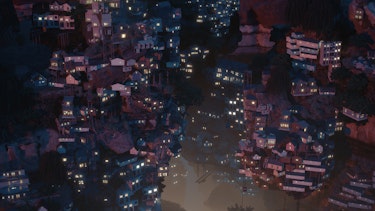The intersection of architecture and game design may seem unexpected at first glance, but upon deeper exploration, it becomes evident that these two disciplines share fundamental principles of creativity, spatial design, and immersive storytelling. Architects turned game creators are leveraging their expertise in spatial design, urban planning, and narrative construction to push the boundaries of gaming experiences. This essay delves into the fascinating journey of architects transitioning into the realm of game design, exploring the synergies between these fields and the innovative contributions they bring to the gaming industry.

Credit: The Gnomon Workshop
Exploring the Nexus of Architecture and Game Design
Architecture and game design both revolve around the creation of immersive environments that engage users on multiple levels. Architects are trained to think spatially, considering how built environments influence human behavior and experience. Similarly, game designers craft virtual worlds that not only serve as backdrops for gameplay but also evoke emotions and foster exploration. This overlap forms the basis for architects to seamlessly transition into game design, bringing with them a unique perspective shaped by their architectural training.
One notable example is Liam Young, an architect and filmmaker who co-founded the think tank Tomorrow's Thoughts Today and the nomadic research studio Unknown Fields Division. Through his work, Young explores speculative futures and alternative realities, themes that also resonate deeply within the gaming landscape. In an interview with Dezeen, Young discusses how his architectural background informs his approach to creating immersive experiences, emphasizing the importance of narrative and world-building in both architecture and gaming.

Credit: Dezeen
Innovating the Gaming Landscape
Architects turned game creators are not merely adapting their skills to fit existing gaming paradigms; rather, they are redefining what games can be. By infusing their projects with architectural sensibilities, these creators are pushing the boundaries of interactive storytelling and spatial exploration.
One prime example is the game "No Man's Sky," developed by Hello Games and led by architect-turned-game designer Sean Murray. "No Man's Sky" is renowned for its procedurally generated universe, allowing players to explore a vast, virtually infinite cosmos filled with diverse planets, flora, and fauna. Murray's background in architecture undoubtedly influenced the game's emphasis on world-building and environmental design, as players traverse landscapes that feel both alien and familiar.
Similarly, the game "Monument Valley," developed by ustwo games, showcases the architectural prowess of its creators. Inspired by the works of M.C. Escher, "Monument Valley" challenges players to navigate impossible architectures and optical illusions, blurring the lines between art, architecture, and gameplay. The game's visually stunning landscapes and intricate puzzles exemplify the fusion of architectural principles with interactive storytelling.
Another noteworthy project is "The Witness," developed by Jonathan Blow, which features a meticulously crafted island filled with enigmatic puzzles and hidden secrets. Blow, although not formally trained as an architect, demonstrates a keen understanding of spatial design and environmental storytelling, drawing players into a world ripe for exploration and discovery.

Credit: The New Yorker
Expanding Impact
The influence of architects turned game creators extends beyond the realm of entertainment, permeating various aspects of contemporary culture and society. Through their games, these creators provoke thought and inspire dialogue on pressing issues such as environmental sustainability, urban development, and social equity.
For instance, the game "SimCity," developed by Will Wright, simulates the complexities of urban planning and governance, allowing players to design and manage their own virtual cities. By engaging with simulated environments, players gain insights into the challenges faced by real-world city planners and policymakers, fostering a deeper understanding of urban dynamics and decision-making processes.
Similarly, the game "Cities: Skylines," developed by Colossal Order, empowers players to build and manage their own cities, tackling issues ranging from traffic congestion to pollution and public health. Through player-driven experimentation and creativity, "Cities: Skylines" serves as a platform for exploring alternative approaches to urban development and envisioning more sustainable and resilient cities.
In addition to addressing urban challenges, architects turned game creators are also exploring the intersection of architecture and social justice. Games such as "This War of Mine," developed by 11 bit studios, immerse players in the harrowing realities of civilian survival during armed conflict, challenging conventional notions of heroism and morality. By placing players in the shoes of ordinary individuals facing extraordinary circumstances, "This War of Mine" prompts reflection on the human cost of war and the ethical dilemmas inherent in armed conflict.

Credit: Paradox Interactive
The journey of architects turned game creators represents a compelling fusion of art, technology, and imagination, transcending disciplinary boundaries to create immersive experiences that captivate and inspire audiences worldwide. From shaping virtual worlds to addressing real-world challenges, these creators are pushing the boundaries of creativity and innovation, enriching both the gaming industry and the broader cultural landscape. As architects continue to explore the potential of game design as a medium for spatial storytelling and social change, the possibilities for collaboration and exploration are boundless, promising a future where virtual worlds and physical spaces converge in unprecedented ways.
